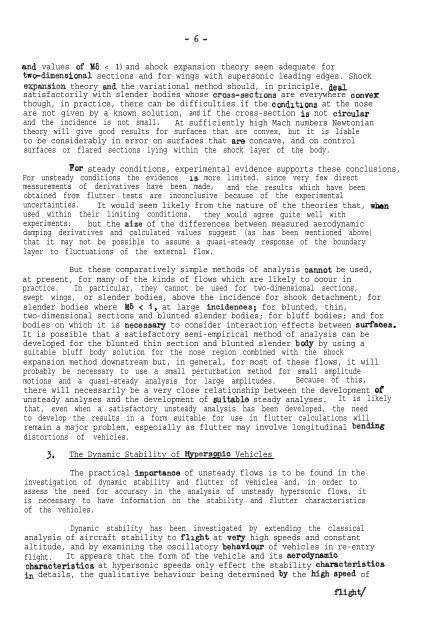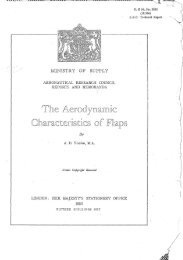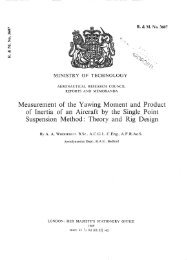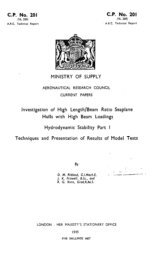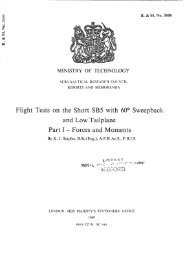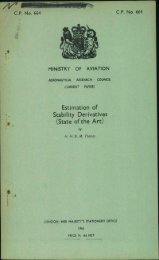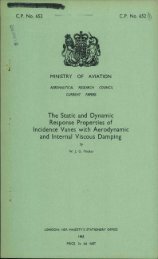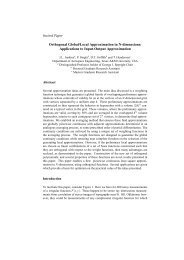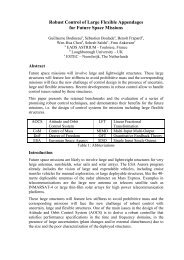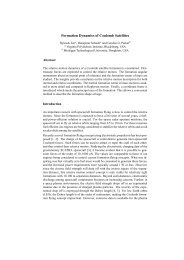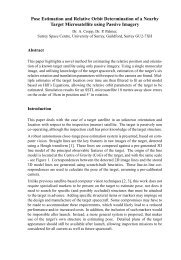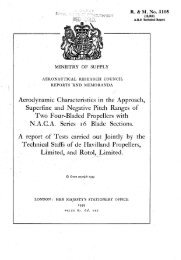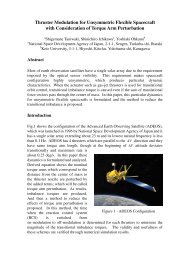A Survey of Unsteady Hypersonic Flow Problems
A Survey of Unsteady Hypersonic Flow Problems
A Survey of Unsteady Hypersonic Flow Problems
You also want an ePaper? Increase the reach of your titles
YUMPU automatically turns print PDFs into web optimized ePapers that Google loves.
-6-<br />
and values <strong>of</strong> M6 < 1) and shock expansion theory seem adequate for<br />
two-dimensional sections and for wings with supersonic leading edges. Shock<br />
expansion theory and the variational method should, in principle, deal<br />
satisfactorily with slender bodies whose cross-sectlons are everywhere convex<br />
though, in practice, there can be difficulties if the condltlons at the nose<br />
are not given by a known solution, and if the cross-section is not circular<br />
and the incidence is not small. At sufficiently high Mach numbers Newtonian<br />
theory will give good results for surfaces that are convex, but it is liable<br />
to be considerably in error on surfaces that ars concave, and on control<br />
surfaces or flared sections lying within the shock layer <strong>of</strong> the body.<br />
For steady conditions, experimental evidence supports these conclusions,<br />
For unsteady conditions the evidence IS more limited. since very few direct<br />
measurements <strong>of</strong> derivatives have been made, and the results which have been<br />
obtained from flutter tests are inconclusive because <strong>of</strong> the experimental<br />
uncertainties. It would seem likely from the nature <strong>of</strong> the theories that, whan<br />
used within their limiting conditions, they would agree quite well with<br />
experiments: but the size <strong>of</strong> the differences between measured aerodynamic<br />
damping derivatives and calculated values suggest (as has been mentioned above)<br />
that it may not be possible to assume a quasi-steady response <strong>of</strong> the boundary<br />
layer to fluctuations <strong>of</strong> the external flow.<br />
But these comparatively simple methods <strong>of</strong> analysis oannot be used,<br />
at present, for many <strong>of</strong> the kinds <strong>of</strong> flows which are likely to ooour in<br />
practice. In particular, they cannot be used for two-dimensional sections,<br />
swept wings, or slender bodies, above the incidence for shook detachment; for<br />
slender bodies where M6 < I, at large incidenoes; for blunted, thin,<br />
two-dimensional sections and blunted slender bodies; for bluff bodies; and for<br />
bodies on which it is neoessaly to consider interaction effects between surfaaes.<br />
It is possible that a satisfactory semi-empirical method <strong>of</strong> analysis can be<br />
developed for the blunted thin section and blunted slender bcdy by using a<br />
suitable bluff body solution for the nose region combined with the shock<br />
expansion method downstream but, in general, for most <strong>of</strong> these flows, it will<br />
probably be necessary to use a small perturbation method for small amplitude<br />
motions and a quasi-steady analysis for large amplitudes. Because <strong>of</strong> this,<br />
there will necessarily be a very close relationship between the development <strong>of</strong><br />
unsteady analyses and the development <strong>of</strong> sultable steady analyses. It is likely<br />
that, even when a satisfactory unsteady analysis has been developed, the need<br />
to develop the results in a form suitable for use in flutter calculations will<br />
remain a major problem, espeoially as flutter may involve longitudinal bend%<br />
distortions <strong>of</strong> vehicles.<br />
3.<br />
The Dynamic Stability <strong>of</strong> &Personic Vehicles<br />
The practical importanoe <strong>of</strong> unsteady flows is to be found in the<br />
investigation <strong>of</strong> dynamic stability and flutter <strong>of</strong> vehicles and, in order to<br />
assess the need for accuracy in the analysis <strong>of</strong> unsteady hypersonic flows, it<br />
is necessary to have information on the stability and flutter characteristics<br />
<strong>of</strong> the vehioles.<br />
Dynamic stability has been investigated by extending the classical<br />
analysis <strong>of</strong> aircraft stability to flight at very high speeds and constant<br />
altitude, and by examining the oscillatory behaviour <strong>of</strong> vehicles in re-entry<br />
flight. It appears that the form <strong>of</strong> the vehicle and its aerodynamic<br />
charaotefistics at hypersonic speeds only effect the stability characteristios<br />
in details, the qualitative behaviour being determined bY the high speed <strong>of</strong>


